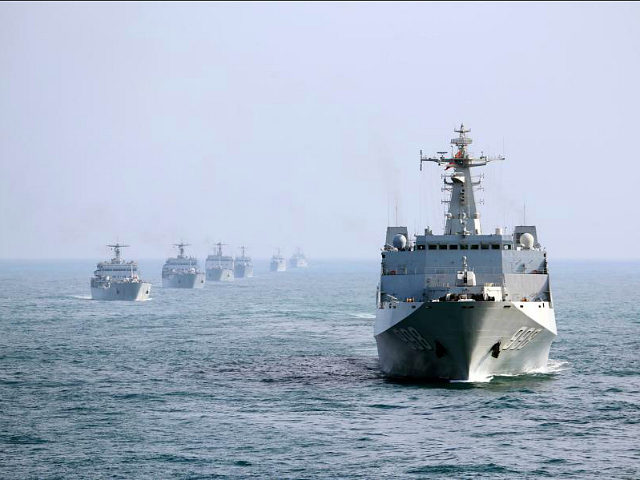The Association of Southeast Asian Nations (ASEAN), currently chaired by the Philippines, is aspiring to debut a new maritime code of conduct by June intended to diminish tensions between member nations and China in the South China Sea.
While the Philippines won an international law case against China’s colonization of international territory in the sea at the Hague last year, current president Rodrigo Duterte has repeatedly insisted he would not act belligerently or challenge China in any way in territories in which Beijing has illegally built artificial islands and installed military technology.
Duterte’s conciliatory approach to China appears at odds with that of his foreign minister, Perfecto Yasay, who triggered outrage in Beijing last week by calling China’s behavior in Philippine waters a matter of “grave concern.”
Yasay told reporters that Manila would consider any construction on the Scarborough Shoal, a Philippine territory China claims as its own, “a game-changer” and a “very serious, provocative act.” Yasay has been the most aggressive voice in the Philippine government against Chinese colonization in the region, going so far as to send an official “note verbale” to Beijing objecting to reports in January that China had begun new construction in the Spratly Islands, another Philippine territory. “When there are reports about the buildup of weapon systems in the area during our watch, we made sure that the interests and rights of the Philippines are properly protected.”
The Chinese Foreign Ministry responded sternly to Yasay’s latest comments against Chinese construction in the Scarborough Shoal. “Mr. Yasay’s recent remarks… run counter to the shared desire of regional countries to maintain peace and stability of the South China Sea and promote regional cooperation,” Foreign Ministry spokesman Geng Shuang said last week. “China finds them baffling and regrettable.”
Duterte responded to the kerfuffle by calling it a “misunderstanding” and reiterating his desire to “talk as friends” with China. “Yasay overdid it,” he told reporters. Before long, headlines in Chinese government-run media began once again touting the friendly relationship between Duterte and Chinese President Xi Jinping.
Yasay is not alone, however, in his alarm regarding China’s claims to almost the entirety of the South China Sea. Deutsche Welle quotes Philippine Department of National Defense (DND) public affairs head Arsenio Andolong as referring to recent China expansion of artificial islands and military facilities in the region as “very troubling” because they are occurring “well within our exclusive economic zone (EEZ).”
“They have used their propaganda and military might to enforce their claim. But we will always keep our lines of communication open to arrive at peaceful solutions to the issues,” Andolong added.
Philippine Department of Foreign Affairs (DFA) spokesman Charles Jose told the outlet that Duterte may change his approach to the problem soon, as “since President Duterte’s visit to China, the situation in the Scarborough Shoal has dramatically changed.” Duterte visited Beijing to meet with Xi personally in October.
Following that visit, China agreed to invest over $14 million in weapons for the Philippine police forces to use in the ongoing war on drugs that became a centerpiece of Duterte’s presidential campaign. Duterte had said publicly he would welcome a new alliance with China and Russia and said “goodbye” to the United States, a longtime ally of the island nation.
On the South China Sea specifically, Duterte had refused to participate in any maritime patrols of “freedom of navigation” exercises. “I will not allow it because I do not want my country to be in involved in a hostile act,” he said in September. “I do not want to ride gung-ho style there with China or with America. I just want to patrol our territorial waters.”
Under President Donald Trump, the United States recently announced a new wave of freedom of navigation exercises intended to limit China’s growing control of the multi-billion-dollar trade route.
What Duterte’s stance means for an ASEAN maritime code of conduct remains to be seen. China claims the territory of at least four member nations — Malaysia, Vietnam, the Philippines, and Brunei — in the South China Sea as its own. ASEAN member nations have a vested interest in enforcing their borders against an increasingly aggressive Beijing. To seek such enforcement, however, Duterte would have to pivot away from a pillar of his administration’s foreign policy: support for China.

COMMENTS
Please let us know if you're having issues with commenting.